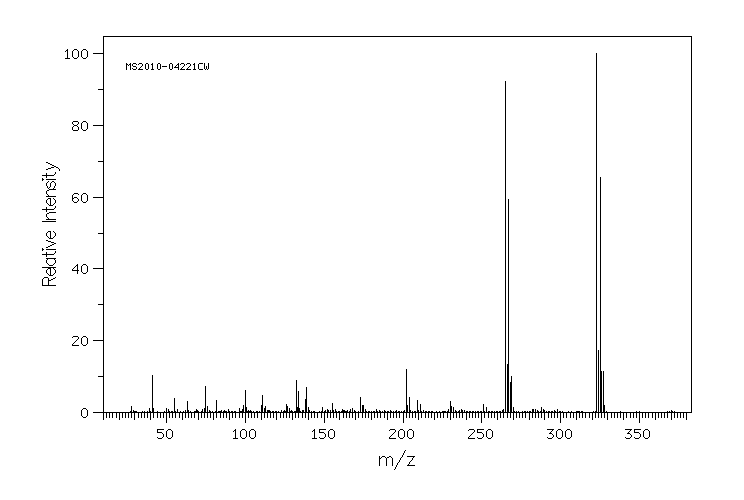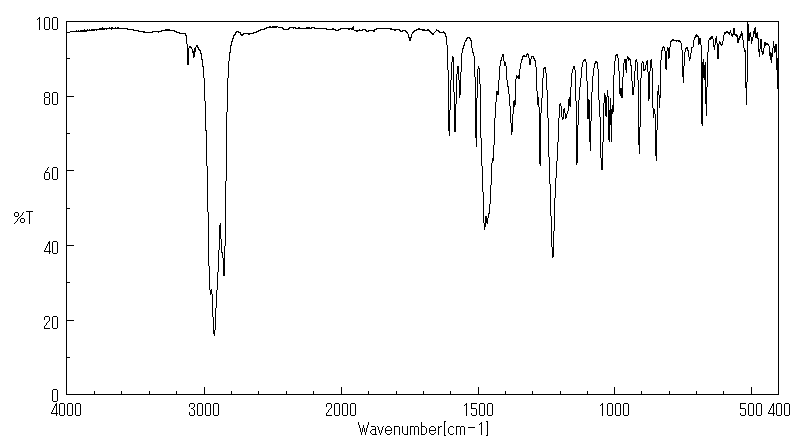苯醚甲环唑 | 119446-68-3
-
物化性质
-
计算性质
-
ADMET
-
安全信息
-
SDS
-
制备方法与用途
-
上下游信息
-
文献信息
-
表征谱图
-
同类化合物
-
相关功能分类
-
相关结构分类
物化性质
-
熔点:76°C
-
沸点:220°C
-
密度:1.4916 (rough estimate)
-
溶解度:氯仿:微溶,甲醇:微溶
-
LogP:4.300
-
颜色/状态:White crystalline solid
-
气味:Odorless
-
蒸汽压力:2.5X10-10 mm Hg at 25 °C (3.3X10-5 mPa)
-
分解:When heated to decomposition it emits toxic vapors of /nitrogen oxides/ and /chloride/.
-
粘度:529 cP at 25 °C
-
解离常数:pKa = 1.1 at 20 °C
-
碰撞截面:198.48 Ų [M+H]+ [CCS Type: TW]
-
保留指数:3136;3136;3136.2;3017;3019;2941.7;3025;3027;2954.1
计算性质
-
辛醇/水分配系数(LogP):4
-
重原子数:27
-
可旋转键数:5
-
环数:4.0
-
sp3杂化的碳原子比例:0.263
-
拓扑面积:58.4
-
氢给体数:0
-
氢受体数:5
ADMET
安全信息
-
危险品标志:Xn
-
安全说明:S26,S36/37/39
-
危险类别码:R22,R41,R43
-
WGK Germany:3
-
危险品运输编号:UN 3077 9 / PGIII
-
RTECS号:XZ4380000
-
储存条件:0-6°C
SDS
模块 1. 化学品
1.1 产品标识符
: 苯醚甲环唑
产品名称
1.2 鉴别的其他方法
无数据资料
1.3 有关的确定了的物质或混合物的用途和建议不适合的用途
仅用于研发。不作为药品、家庭或其它用途。
模块 2. 危险性概述
2.1 GHS-分类
急性毒性, 经口 (类别 4)
急性毒性, 吸入 (类别 4)
急性毒性, 经皮 (类别 5)
皮肤刺激 (类别 3)
急性水生毒性 (类别 1)
慢性水生毒性 (类别 1)
2.2 GHS 标记要素,包括预防性的陈述
象形图
警示词 警告
危险申明
H302 + H332 如果咽下或吸入是有害的。
H313 接触皮肤可能有害。
H316 引起轻微皮肤刺激。
H410 对水生生物毒性极大并具有长期持续影响.
警告申明
预防措施
P261 避免吸入粉尘/烟/气体/烟雾/蒸气/喷雾.
P264 操作后彻底清洁皮肤。
P270 使用本产品时不要进食、饮水或吸烟。
P271 只能在室外或通风良好之处使用。
P273 避免释放到环境中。
事故响应
P301 + P312 如果吞咽并觉不适: 立即呼叫解毒中心或就医。
P304 + P340 如果吸入:将受害人移至空气新鲜处并保持呼吸舒适的姿势休息。
P312 如感觉不适,呼救中毒控制中心或医生.
P330 漱口。
P391 收集溢出物。
废弃处置
P501 将内容物/ 容器处理到得到批准的废物处理厂。
当心 - 物质尚未完全测试。
2.3 其它危害物 - 无
模块 3. 成分/组成信息
3.1 物 质
: C19H17Cl2N3O3
分子式
: 406.26 g/mol
分子量
组分 浓度或浓度范围
Difenoconazole
<=100%
化学文摘登记号(CAS 119446-68-3
No.)
模块 4. 急救措施
4.1 必要的急救措施描述
一般的建议
请教医生。 向到现场的医生出示此安全技术说明书。
吸入
如果吸入,请将患者移到新鲜空气处。 如呼吸停止,进行人工呼吸。 请教医生。
皮肤接触
用肥皂和大量的水冲洗。 请教医生。
眼睛接触
用水冲洗眼睛作为预防措施。
食入
切勿给失去知觉者通过口喂任何东西。 用水漱口。 请教医生。
4.2 主要症状和影响,急性和迟发效应
4.3 及时的医疗处理和所需的特殊处理的说明和指示
无数据资料
模块 5. 消防措施
5.1 灭火介质
灭火方法及灭火剂
用水雾,抗乙醇泡沫,干粉或二氧化碳灭火。
5.2 源于此物质或混合物的特别的危害
碳氧化物, 氮氧化物, 氯化氢气体
5.3 给消防员的建议
如必要的话,戴自给式呼吸器去救火。
5.4 进一步信息
无数据资料
模块 6. 泄露应急处理
6.1 作业人员防护措施、防护装备和应急处置程序
使用个人防护用品。 避免粉尘生成。 避免吸入蒸气、烟雾或气体。 保证充分的通风。 避免吸入粉尘。
6.2 环境保护措施
如能确保安全,可采取措施防止进一步的泄漏或溢出。 不要让产品进入下水道。
一定要避免排放到周围环境中。
6.3 泄漏化学品的收容、清除方法及所使用的处置材料
收集和处置时不要产生粉尘。 扫掉和铲掉。 放入合适的封闭的容器中待处理。
6.4 参考其他部分
丢弃处理请参阅第13节。
模块 7. 操作处置与储存
7.1 安全操作的注意事项
避免接触皮肤和眼睛。 避免形成粉尘和气溶胶。
在有粉尘生成的地方,提供合适的排风设备。
7.2 安全储存的条件,包括任何不兼容性
贮存在阴凉处。 使容器保持密闭,储存在干燥通风处。
7.3 特定用途
无数据资料
模块 8. 接触控制和个体防护
8.1 容许浓度
最高容许浓度
没有已知的国家规定的暴露极限。
8.2 暴露控制
适当的技术控制
根据良好的工业卫生和安全规范进行操作。 休息前和工作结束时洗手。
个体防护设备
眼/面保护
带有防护边罩的安全眼镜符合 EN166要求请使用经官方标准如NIOSH (美国) 或 EN 166(欧盟)
检测与批准的设备防护眼部。
皮肤保护
戴手套取 手套在使用前必须受检查。
请使用合适的方法脱除手套(不要接触手套外部表面),避免任何皮肤部位接触此产品.
使用后请将被污染过的手套根据相关法律法规和有效的实验室规章程序谨慎处理. 请清洗并吹干双手
所选择的保护手套必须符合EU的89/686/EEC规定和从它衍生出来的EN 376标准。
完全接触
物料: 丁腈橡胶
最小的层厚度 0.11 mm
溶剂渗透时间: 480 min
测试过的物质Dermatril® (KCL 740 / Z677272, 规格 M)
飞溅保护
物料: 丁腈橡胶
最小的层厚度 0.11 mm
溶剂渗透时间: 480 min
测试过的物质Dermatril® (KCL 740 / Z677272, 规格 M)
, 测试方法 EN374
如果以溶剂形式应用或与其它物质混合应用,或在不同于EN
374规定的条件下应用,请与EC批准的手套的供应商联系。
这个推荐只是建议性的,并且务必让熟悉我们客户计划使用的特定情况的工业卫生学专家评估确认才可.
这不应该解释为在提供对任何特定使用情况方法的批准.
身体保护
全套防化学试剂工作服, 防护设备的类型必须根据特定工作场所中的危险物的浓度和数量来选择。
呼吸系统防护
如须暴露于有害环境中,请使用P95型(美国)或P1型(欧盟 英国
143)防微粒呼吸器。如需更高级别防护,请使用OV/AG/P99型(美国)或ABEK-P2型 (欧盟 英国 143)
防毒罐。
呼吸器使用经过测试并通过政府标准如NIOSH(US)或CEN(EU)的呼吸器和零件。
模块 9. 理化特性
9.1 基本的理化特性的信息
a) 外观与性状
形状: 固体
b) 气味
无数据资料
c) 气味阈值
无数据资料
d) pH值
无数据资料
e) 熔点/凝固点
无数据资料
f) 沸点、初沸点和沸程
无数据资料
g) 闪点
无数据资料
h) 蒸发速率
无数据资料
i) 易燃性(固体,气体)
无数据资料
j) 高的/低的燃烧性或爆炸性限度 无数据资料
k) 蒸气压
无数据资料
l) 蒸汽密度
无数据资料
m) 密度/相对密度
无数据资料
n) 水溶性
0.015 g/l 在 25 °C
o) n-辛醇/水分配系数
辛醇--水的分配系数的对数值: 3.975
p) 自燃温度
无数据资料
q) 分解温度
无数据资料
r) 粘度
无数据资料
模块 10. 稳定性和反应活性
10.1 反应性
无数据资料
10.2 稳定性
无数据资料
10.3 危险反应
无数据资料
10.4 应避免的条件
无数据资料
10.5 不相容的物质
强氧化剂
10.6 危险的分解产物
模块 11. 毒理学资料
11.1 毒理学影响的信息
急性毒性
半数致死剂量 (LD50) 经口 - 大鼠 - 1,453 mg/kg
半数致死浓度(LC50) 吸入 - 大鼠 - 4 h - 3,300 mg/m3
半数致死剂量 (LD50) 经皮 - 兔子 - > 2,010 mg/kg
皮肤刺激或腐蚀
皮肤 - 兔子 - 轻度的皮肤刺激
眼睛刺激或腐蚀
眼睛 - 兔子 - 无眼睛刺激
呼吸道或皮肤过敏
长期或反复接触导致个别人过敏反应 前面的数据或数据判读是根据定量结构活性关系(QSAR)确定的。
生殖细胞致突变性
无数据资料
致癌性
IARC:
此产品中没有大于或等于 0。1%含量的组分被 IARC鉴别为可能的或肯定的人类致癌物。
生殖毒性
生殖毒性 - 大鼠 - 经口
母体效应:其他影响。 特定发育异常:肌肉骨骼系统。
特异性靶器官系统毒性(一次接触)
无数据资料
特异性靶器官系统毒性(反复接触)
无数据资料
吸入危险
无数据资料
潜在的健康影响
吸入 吸入有害。 可能引起呼吸道刺激。
摄入 误吞对人体有害。
皮肤 通过皮肤吸收可能有害。 可能引起皮肤刺激。
眼睛 可能引起眼睛刺激。
附加说明
化学物质毒性作用登记: XZ4380000
模块 12. 生态学资料
12.1 生态毒性
对鱼类的毒性 半数致死浓度(LC50) - 虹鳟 (红鳟鱼) - 0.81 mg/l - 96 h
对水蚤和其他水生无脊 半数效应浓度(EC50) - 大型蚤 (水蚤) - 0.77 mg/l - 48 h
椎动物的毒性
12.2 持久性和降解性
无数据资料
12.3 潜在的生物累积性
无数据资料
12.4 土壤中的迁移性
无数据资料
12.5 PBT 和 vPvB的结果评价
无数据资料
12.6 其它不良影响
对水生生物毒性极大并具有长期持续影响.
无数据资料
模块 13. 废弃处置
13.1 废物处理方法
产品
将剩余的和不可回收的溶液交给有许可证的公司处理。
与易燃溶剂相溶或者相混合,在备有燃烧后处理和洗刷作用的化学焚化炉中燃烧
受污染的容器和包装
按未用产品处置。
模块 14. 运输信息
14.1 联合国危险货物编号
欧洲陆运危规: 3077 国际海运危规: 3077 国际空运危规: 3077
14.2 联合国运输名称
欧洲陆运危规: ENVIRONMENTALLY HAZARDOUS SUBSTANCE, SOLID, N.O.S. (Difenoconazole)
国际海运危规: ENVIRONMENTALLY HAZARDOUS SUBSTANCE, SOLID, N.O.S. (Difenoconazole)
国际空运危规: EnvironmeNTAlly hazardous subSTance, solid, n.o.s. (Difenoconazole)
14.3 运输危险类别
欧洲陆运危规: 9 国际海运危规: 9 国际空运危规: 9
14.4 包裹组
欧洲陆运危规: III 国际海运危规: III 国际空运危规: III
14.5 环境危险
欧洲陆运危规: 是 国际海运危规 国际空运危规: 是
海洋污染物(是/否): 是
14.6 对使用者的特别提醒
进一步信息
危险品独立包装,液体5升以上或固体5公斤以上,每个独立包装外和独立内包装合并后的外包装上都必须有EHS
标识 (根据欧洲 ADR 法规 2.2.9.1.10, IMDG 法规 2.10.3),
模块 15 - 法规信息
N/A
模块16 - 其他信息
N/A
制备方法与用途
苯醚甲环唑,又名噁醚唑,商品名为“世高”,属于三唑类杀菌剂。它是一种甾醇脱甲基化抑制剂,具有高效、广谱、低毒和用量低的特点,是三唑类杀菌剂中的优良品种之一。其内吸性强,通过抑制病菌细胞麦角甾醇的生物合成,破坏病原菌细胞膜结构与功能,用于果树、蔬菜、小麦、马铃薯、豆类、瓜类等作物。它对多种真菌性病害具有很好的保护和治疗作用,并且具有“三不”(不污染环境、不污染农产品、不杀伤天敌)的特点,是目前我国乃至世界各国防治柑橘疮痂病、斑点落叶病等作物抗性病害的理想杀菌剂。
作用机制苯醚甲环唑水分散粒剂为米黄至棕色细粒。它对植物病原菌的孢子形成具有强烈抑制作用,并能抑制分生孢子成熟,从而控制病情进一步发展。苯醚甲环唑的作用方式是通过干扰病原菌细胞的C14脱甲基化作用,抑制麦角甾醇的生物合成,从而使甾醇滞留于细胞膜内,损坏了膜的生理作用,导致真菌死亡。
特点-
内吸传导,杀菌谱广:苯醚甲环唑是一种高效、安全、低毒、广谱性杀菌剂。可被植物内吸,渗透作用强。施药后2小时内即被作物吸收,并有向上传导的特性,能使新生的幼叶、花、果免受病菌为害。能一药多治,对多种真菌性病害都有良好的防治效果。能有效地防治蔬菜的黑星病、叶斑病、白粉病及锈病,兼具预防和治疗作用。
-
耐雨冲刷、药效持久:黏着在叶面的药剂耐雨水冲刷,从叶片挥发极少,即使在高温条件下也表现较持久的杀菌活性,比一般杀菌剂持效期长3~4天。
-
剂型先进,作物安全:水分散粒剂由有效成份、分散剂、湿润剂、崩解剂、消泡剂、黏合剂和防结块剂等助剂通过微细化、喷雾干燥等工艺造粒。投入水中可迅速崩解分散,形成高悬浮分散体系,无粉尘影响,对使用者及环境安全。不含有机溶剂,对推荐作物安全。
以间二氯苯为原料,经酰化、醚化、溴化、环化和缩合反应,最终合成苯醚甲环唑。图1为苯醚甲环唑的合成路线。
适宜作物西红柿、甜菜、香蕉、禾谷类作物、水稻、大豆、园艺作物及各种蔬菜等。对小麦、大麦进行茎叶(小麦株高24~42cm)处理时,有时叶片会出现变色现象,但不会影响产量。
化学性质和用途 防治对象苯醚甲环唑对子囊亚门、担子菌亚门以及包括链格孢属、壳二孢属、尾孢霉属、刺盘孢属、球座菌属、茎点霉属、柱隔孢属、壳针孢属、黑星菌属在内的半知菌,白粉菌科,锈菌目和某些种传病原菌有持久的保护和治疗活性。同时对甜菜褐斑病、小麦颖枯病、叶枯病、锈病以及由几种致病菌引起的霉病,苹果黑星病、白粉病,葡萄白粉病,马铃薯早疫病,花生叶斑病、网斑病等均有较好的治疗效果。
上下游信息
-
上游原料
中文名称 英文名称 CAS号 化学式 分子量 —— 2-methyl-2-[2-chloro-4-(4-chlorophenoxy)phenyl]-4-methyl-1,3-dioxolane 441347-97-3 C17H16Cl2O3 339.218 2-(溴甲基)-2-[2-氯-4-(4-氯苯氧基)苯基]-4-甲基-1,3-二氧戊环 2-(bromomethyl)-2-(2-chloro-4-(4-chlorophenoxy)phenyl)-4-methyl-1,3-dioxolane 873012-43-2 C17H15BrCl2O3 418.114 —— 2-(2,4-dichlorophenyl)-2-bromomethyl-4-methyl-1,3-dioxolane 60207-34-3 C11H11BrCl2O2 326.017 -
下游产品
中文名称 英文名称 CAS号 化学式 分子量 —— 2-[2-chloro-4-(4-chloro-phenoxy)-phenyl]-2-[(5-mercapto-1,2,4-triazol-1-yl)-methyl]-4-methyl-1,3-dioxolan —— C19H17Cl2N3O3S 438.334
反应信息
-
作为反应物:参考文献:名称:[EN] A PROCESS USING GRIGNARD REAGENTS
[FR] PROCÉDÉ UTILISANT DES RÉACTIFS DE GRIGNARD摘要:本发明涉及一种利用格氏试剂提供含硫代三唑基团化合物的过程。公开号:WO2011113820A1 -
作为产物:描述:1,3-二氯苯 在 aluminum (III) chloride 、 双氧水 、 溴 、 对甲苯磺酸 、 咪唑氢溴酸盐(低含水量) 、 potassium hydroxide 作用下, 以 二氯甲烷 、 环己烷 、 N,N-二甲基甲酰胺 为溶剂, 反应 25.0h, 生成 苯醚甲环唑参考文献:名称:一种苯醚甲环唑的制备方法摘要:本申请涉及杀菌剂技术领域,具体公开了一种苯醚甲环唑的制备方法。一种苯醚甲环唑的制备方法,包括以下步骤:2–氯‑4‑(4‑氯苯氧基)苯乙酮依次经溴化反应、环化反应、缩合反应,得到苯醚甲环唑粗品;苯醚甲环唑粗品再经纯化后得到成品苯醚甲环唑;合成路线用反应方程式表示如下: 。本申请所提供的苯醚甲环唑的生产工艺溴素利用率较高,可以有效改善生产苯醚甲环唑的经济效益和环境效益。公开号:CN115745973A
文献信息
-
[EN] ACC INHIBITORS AND USES THEREOF<br/>[FR] INHIBITEURS DE L'ACC ET UTILISATIONS ASSOCIÉES
-
[EN] BICYCLYL-SUBSTITUTED ISOTHIAZOLINE COMPOUNDS<br/>[FR] COMPOSÉS ISOTHIAZOLINE SUBSTITUÉS PAR UN BICYCLYLE申请人:BASF SE公开号:WO2014206910A1公开(公告)日:2014-12-31The present invention relates to bicyclyl-substituted isothiazoline compounds of formula (I) wherein the variables are as defined in the claims and description. The compounds are useful for combating or controlling invertebrate pests, in particular arthropod pests and nematodes. The invention also relates to a method for controlling invertebrate pests by using these compounds and to plant propagation material and to an agricultural and a veterinary composition comprising said compounds.本发明涉及公式(I)中变量如索权和说明中所定义的自行车基取代异噻唑啉化合物。这些化合物对抗或控制无脊椎动物害虫,特别是节肢动物害虫和线虫方面具有用途。该发明还涉及一种通过使用这些化合物来控制无脊椎动物害虫的方法,以及包含所述化合物的植物繁殖材料、农业和兽医组合物。
-
[EN] AZOLINE COMPOUNDS<br/>[FR] COMPOSÉS AZOLINE申请人:BASF SE公开号:WO2015128358A1公开(公告)日:2015-09-03The present invention relates to azoline compounds of formula (I) wherein A, B1, B2, B3, G1, G2, X1, R1, R3a, R3b, Rg1 and Rg2 are as defined in the claims and the description. The compounds are useful for combating or controlling invertebrate pests, in particular arthropod pests and nematodes. The invention also relates to a method for controlling invertebrate pests by using these compounds and to plant propagation material and to an agricultural and a veterinary composition comprising said compounds.本发明涉及式(I)的噁唑啉化合物,其中A、B1、B2、B3、G1、G2、X1、R1、R3a、R3b、Rg1和Rg2如权利要求和描述中所定义。这些化合物对抗或控制无脊椎动物害虫,特别是节肢动物害虫和线虫方面具有用途。该发明还涉及一种利用这些化合物控制无脊椎动物害虫的方法,以及包括所述化合物的植物繁殖材料、农业和兽医组合物。
-
[EN] SUBSTITUTED QUINAZOLINES AS FUNGICIDES<br/>[FR] QUINAZOLINES SUBSTITUÉES, UTILISÉES EN TANT QUE FONGICIDES申请人:SYNGENTA PARTICIPATIONS AG公开号:WO2010136475A1公开(公告)日:2010-12-02The present invention relates to a compound of formula (I) wherein wherein the substituents have the definitions as defined in claim 1or a salt or a N-oxide thereof, their use and methods for the control and/or prevention of microbial infection, particularly fungal infection, in plants and to processes for the preparation of these compounds.本发明涉及一种具有如下式(I)的化合物,其中取代基具有权利要求1中定义的定义,或其盐或N-氧化物,它们的用途以及用于控制和/或预防植物中微生物感染,特别是真菌感染的方法,以及制备这些化合物的方法。
-
[EN] MICROBIOCIDAL OXADIAZOLE DERIVATIVES<br/>[FR] DÉRIVÉS D'OXADIAZOLE MICROBIOCIDES申请人:SYNGENTA PARTICIPATIONS AG公开号:WO2017157962A1公开(公告)日:2017-09-21Compounds of the formula (I) wherein the substituents are as defined in claim 1, useful as a pesticides, especially fungicides.式(I)的化合物,其中取代基如权利要求1所定义,作为杀虫剂特别是杀菌剂有用。
表征谱图
-
氢谱1HNMR
-
质谱MS
-
碳谱13CNMR
-
红外IR
-
拉曼Raman
-
峰位数据
-
峰位匹配
-
表征信息








